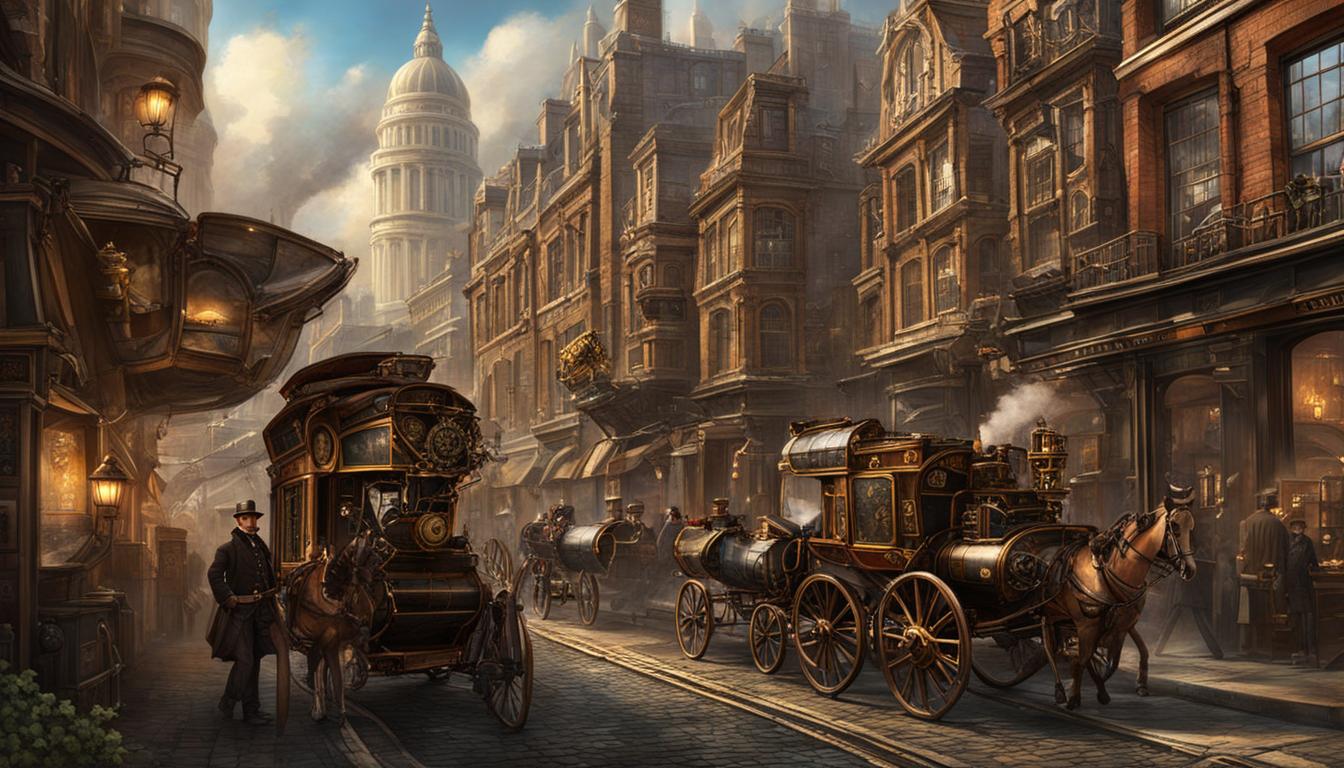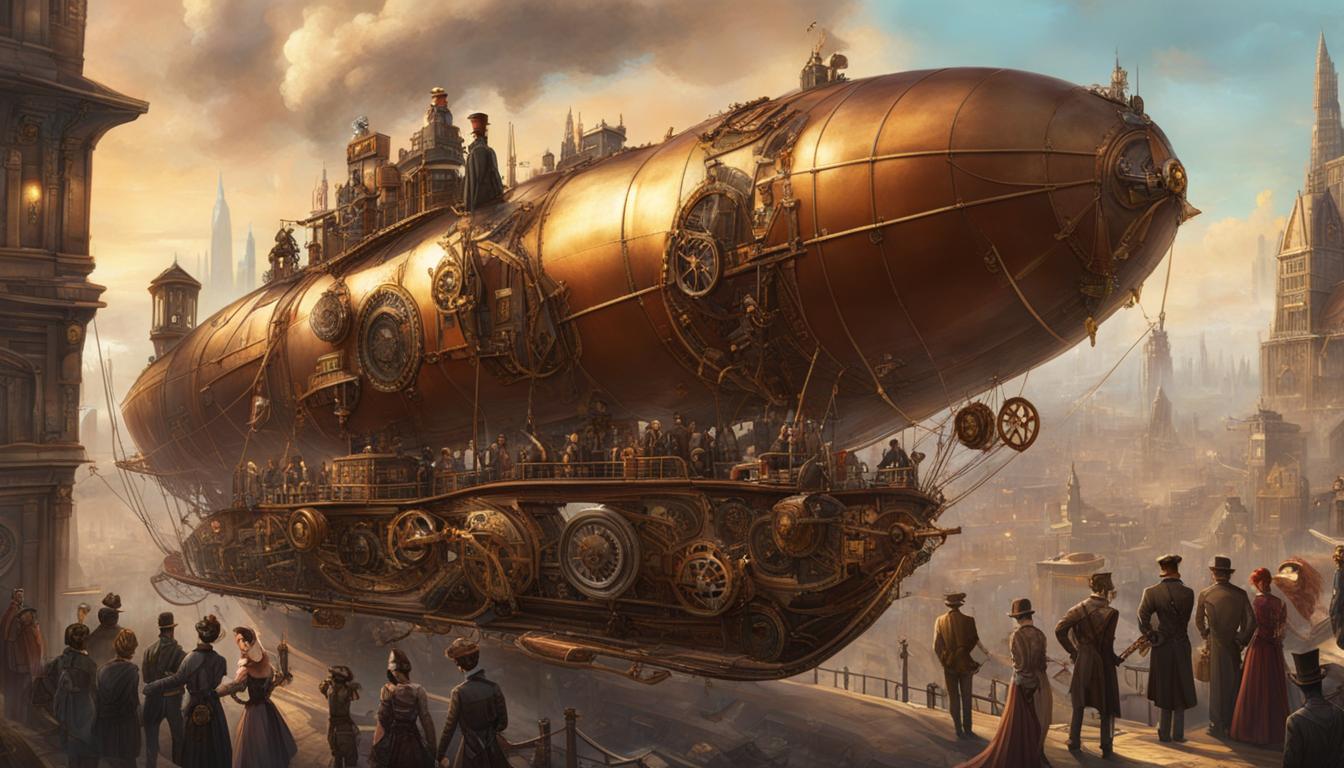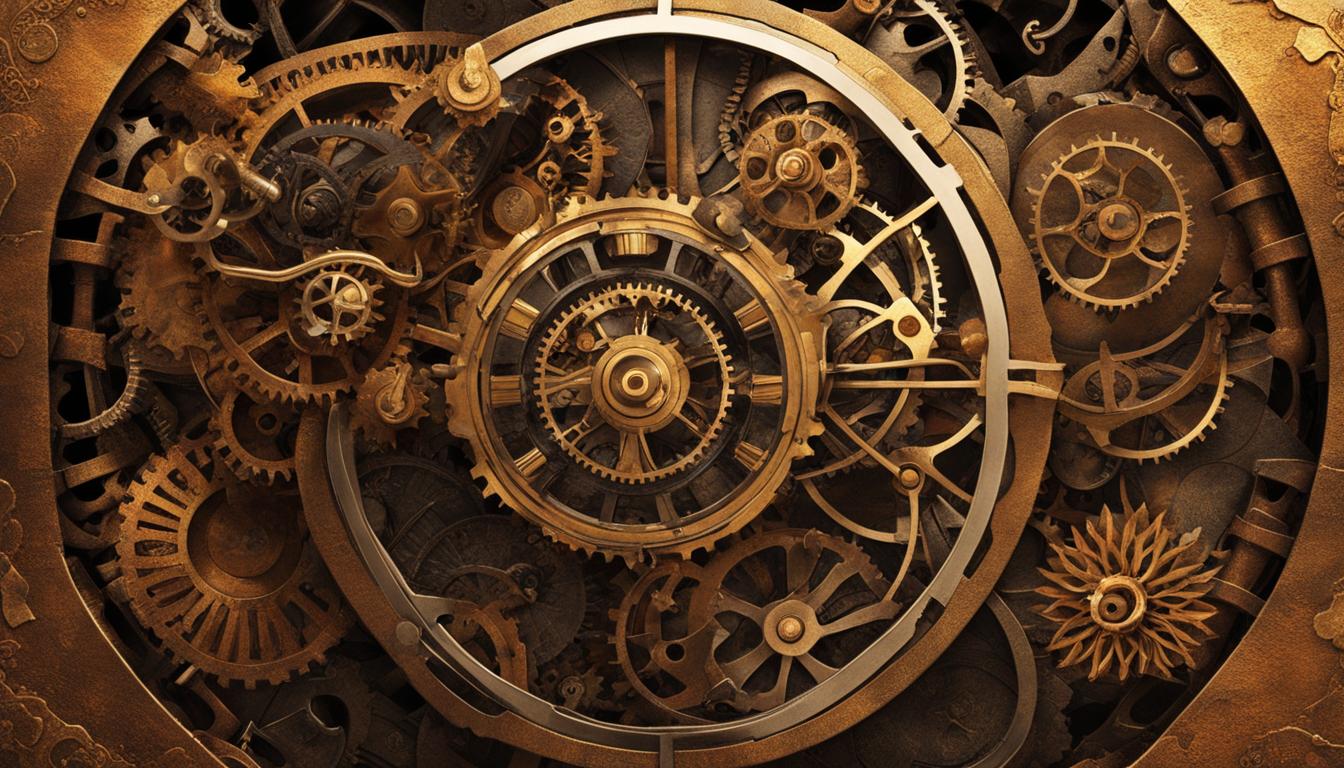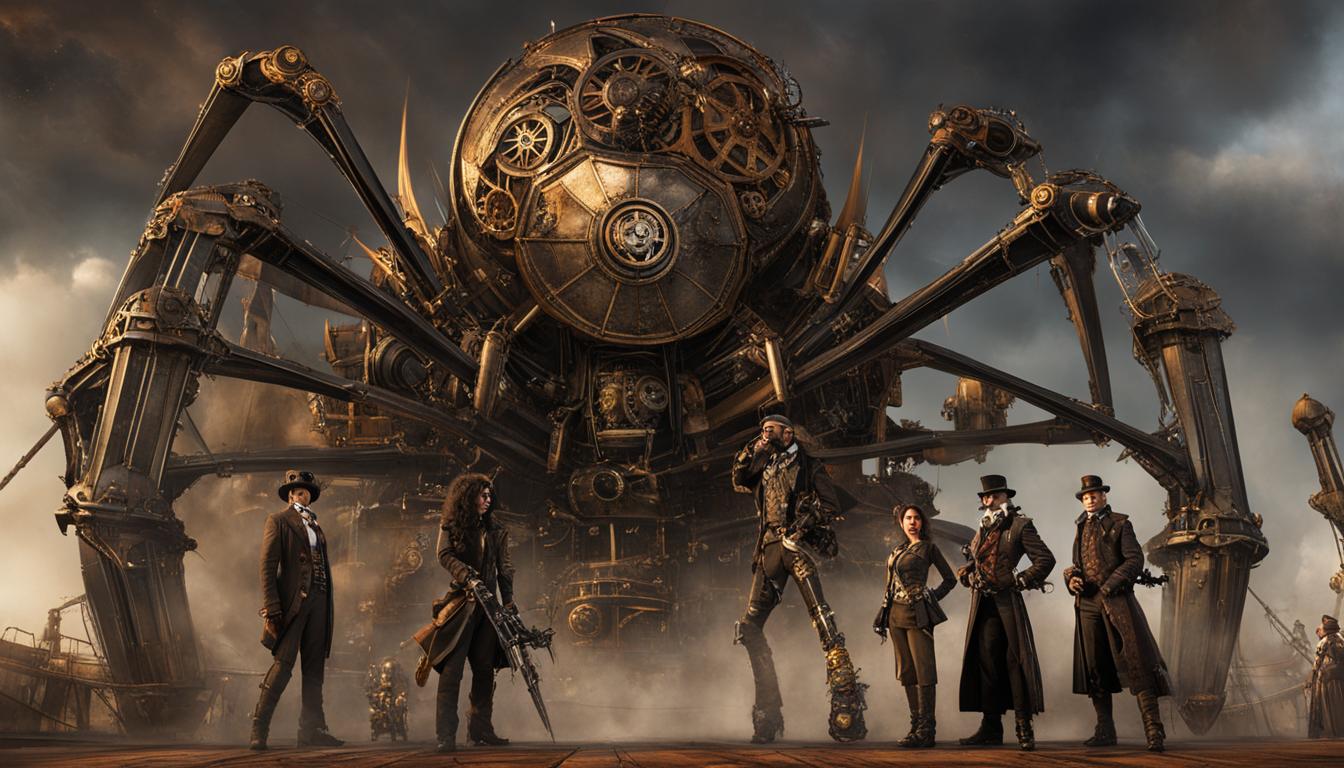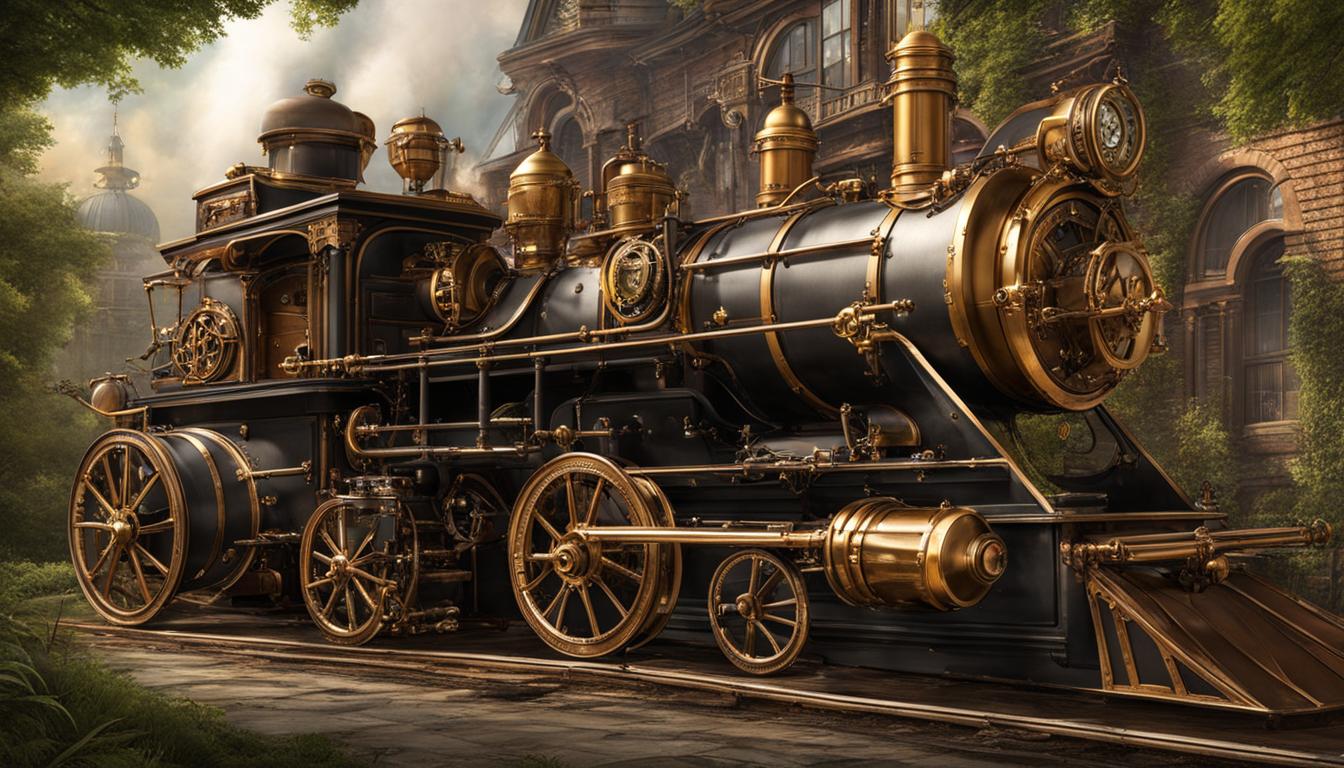Steampunk, a subgenre of science fiction, offers a captivating vision of an altered Victorian era. Combining elements of the 19th-century Victorian era with futuristic ideas, it creates a world brimming with astonishing inventions and peculiar fashion.
Imagine a Victorian London transformed by steam-powered technology, where airships dot the sky and clockwork contraptions fill the streets. This retrofuturistic blend of past and future has taken the world by storm, inspiring artists, fashion designers, and filmmakers.
Key Takeaways:
- Steampunk envisions an altered Victorian era through the fusion of past and future.
- It combines 19th-century steam-powered technology with futuristic innovations.
- Steampunk has influenced various forms of art, fashion, and film.
- The subgenre challenges societal norms and offers a fresh perspective on history.
- Retrofuturistic Victorian fashion is a distinctive feature of steampunk.
Exploring the Historical Context of Steampunk
Steampunk literature and art often transport us to an alternative Victorian era, where steam-powered technology and alternative historical narratives shape the landscape. To fully appreciate the richness and nuance of this subgenre, it is essential to understand its deep roots in the historical context of the Victorian era and the Industrial Revolution.
In Victorian society, strict social hierarchies and moral codes governed everyday life. Steampunk authors take these norms and reimagine them in a world where steam technology has led to even more advanced and fantastical inventions. This blend of Victorian sensibilities with futuristic machinery creates a visually striking aesthetic and challenges societal norms.
One fascinating aspect of steampunk is its exploration of alternative social norms and etiquette. Victorian etiquette is reimagined with a steampunk twist, adding intrigue and complexity to the narratives. In these worlds, Victorian social norms are both preserved and subverted, creating a dynamic and thought-provoking backdrop for the stories.
Exploring Victorian Inventions in Steampunk
A key element of steampunk is the vivid portrayal of Victorian inventions through a retrofuturistic lens. Steampunk worlds often showcase incredible steam-powered machines, intricate clockwork mechanisms, and fantastical contraptions. These inventions not only provide a backdrop for the narrative but also offer a glimpse into the creativity and ingenuity of the Victorian era.
The steampunk genre allows authors and artists to explore what could have been, envisioning a world where steam-powered technology took on even greater significance. From airships sailing through the skies to mechanical automatons performing intricate tasks, steampunk brings Victorian inventions to life in new and imaginative ways.
By delving into the historical context and reimagining Victorian society and inventions, steampunk offers an immersive experience that captivates the imagination and invites readers to explore an altered Victorian era.
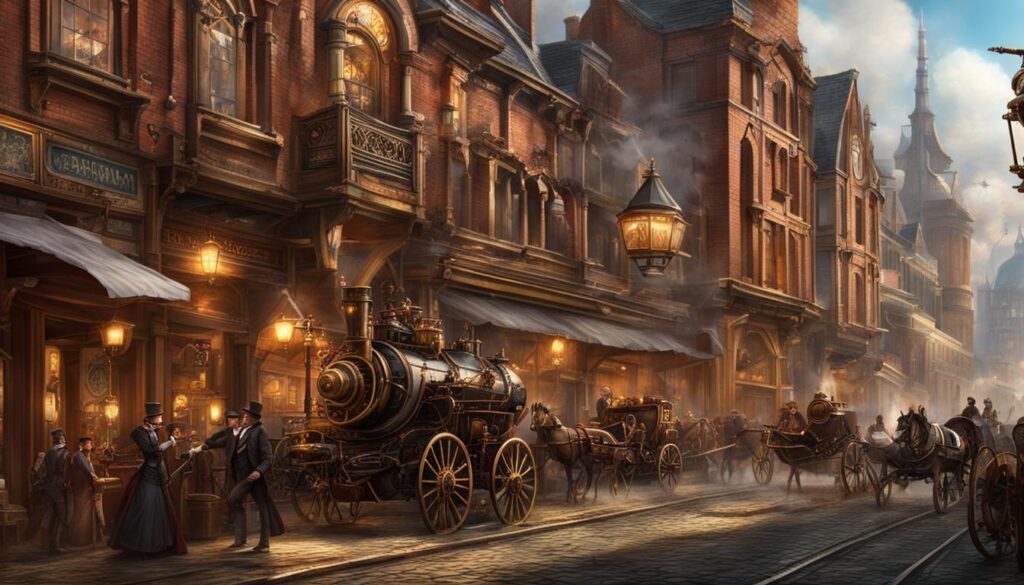
| Victorian Etiquette in Steampunk Worlds | Steampunk’s Vision of Victorian Inventions | Victorian Social Norms with a Steampunk Twist |
|---|---|---|
| Challenges and subverts traditional Victorian etiquette, incorporating steam-powered technology and alternative social structures. | Highlights the ingenuity and creativity of the Victorian era through retrofuturistic inventions, providing an awe-inspiring backdrop for narratives. | Explores the dualities of Victorian social norms, preserving some while subverting others, adding complexity to the characters and plot. |
| Transports readers to a world where strict social hierarchies are reimagined, offering a fresh perspective on societal norms. | Showcases the potential of steam-powered machinery and presents an alternative vision of how Victorian inventions could have evolved. | Creates a thought-provoking dynamic between traditional Victorian social norms and the futuristic elements of steampunk. |
Themes in Steampunk Literature
Steampunk literature explores a variety of captivating themes that captivate readers and transport them to an alternative Victorian era. One of the prominent themes found in steampunk is the reimagining of Victorian politics. In these stories, authors present alternative political systems and power dynamics, often challenging the traditional structures of the time. This allows for thought-provoking narratives that offer social commentary and explore the possibilities of different political ideologies.
Another theme commonly explored in steampunk literature is the portrayal of Victorian explorers in exciting adventures. These stories take readers on thrilling journeys through reimagined landscapes of the Victorian era. From steam-powered airships soaring through the skies to underground tunnels hiding mysterious secrets, steampunk adventures provide a unique blend of historical exploration and fantastical elements.
Victorian landscapes are also creatively reimagined in steampunk literature. Authors transport readers to a world where steam-powered technology has drastically altered the physical environment. They depict sprawling cities filled with towering clockwork structures, intricate machinery intertwined with nature, and bustling streets illuminated by the warm glow of gas lamps. These reimagined landscapes serve as a backdrop for the narratives, further immersing readers in the intricate and visually captivating world of steampunk.
| Table: Themes in Steampunk Literature | Description |
|---|---|
| Alternative Victorian politics in steampunk | Authors present alternative political systems and challenge traditional structures of the Victorian era. |
| Victorian explorers in steampunk adventures | Exciting journeys through reimagined landscapes, involving steam-powered airships and mysterious secrets. |
| Victorian landscapes reimagined | Steampunk authors create visually captivating worlds with clockwork structures, intricate machinery, and gas-lit streets. |
“Steampunk literature takes readers on thrilling adventures through alternative Victorian landscapes, challenges conventional political systems, and reimagines the role of Victorian explorers. It offers a unique blend of historical elements and fantastical imaginings, captivating readers with its visually stunning and thought-provoking narratives.” – Anonymous
Notable Steampunk Works
The Steampunk subgenre has produced a plethora of captivating and imaginative works that showcase its unique blend of Victorian aesthetics and futuristic concepts. These notable Steampunk works offer readers a thrilling journey through alternative histories and fantastical realms. From reimagined Victorian industry to mysteries woven with steampunk elements, these books are sure to transport readers to a world of wonder and adventure.
One notable Steampunk work is “The Difference Engine” by William Gibson and Bruce Sterling. This novel explores the idea of an alternative history where Charles Babbage’s Analytical Engine, a mechanical computer, was successfully built in the Victorian era. The story delves into the implications of this technological advancement on society and politics, presenting a captivating vision of a steam-powered digital age.
Another fascinating work is “Mortal Engines” by Philip Reeve. Set in a post-apocalyptic world where cities roam on massive traction engines, the book follows the thrilling adventures of Tom Natsworthy as he uncovers dark secrets and navigates the complex dynamics of a world driven by steampunk technology. This novel combines elements of mystery, adventure, and social commentary, making it a must-read for fans of the genre.
| Notable Steampunk Works | Author |
|---|---|
| “The Difference Engine” | William Gibson and Bruce Sterling |
| “Mortal Engines” | Philip Reeve |
For those seeking a thrilling combination of the Victorian era and supernatural mysteries, “Boneshaker” by Cherie Priest is a fantastic choice. This novel takes readers on a journey through an alternate Gold Rush-era Seattle, plagued by a deadly gas that turns people into zombies. With its rich atmosphere and dynamic characters, “Boneshaker” showcases the diversity and creativity of the Steampunk genre.
“Perdido Street Station” by China Miéville is another remarkable Steampunk work that pushes the boundaries of the genre. This novel presents a sprawling city filled with strange creatures, industrialized magic, and socio-political turmoil. Miéville’s vivid imagination and intricate world-building create a compelling narrative that explores themes of ambition, power, and societal decay.
Lastly, “Airborn” by Kenneth Oppel offers readers an exhilarating adventure set in a steampunk-inspired world of flying airships and exploration. The story follows a young cabin boy named Matt Cruse as he embarks on a journey filled with intrigue, friendship, and the discovery of hidden secrets. Oppel’s vivid descriptions and engaging characters make “Airborn” a delightful read for Steampunk enthusiasts and adventure lovers alike.
“Steampunk is a genre that allows authors to blend the beauty and charm of the Victorian era with the excitement and possibilities of futuristic technology. These notable works exemplify the genre’s ability to transport readers to imaginative worlds and explore unique narratives.”
Table: Notable Steampunk Works
| Title | Author |
|---|---|
| “The Difference Engine” | William Gibson and Bruce Sterling |
| “Mortal Engines” | Philip Reeve |
| “Boneshaker” | Cherie Priest |
| “Perdido Street Station” | China Miéville |
| “Airborn” | Kenneth Oppel |
The Importance of Research in Steampunk Writing
Research is a crucial aspect of crafting an authentic and captivating Steampunk story. To truly transport readers into a world that blends the Victorian era with futuristic ideas, writers must delve deep into the historical context and technological advancements of the time. By understanding the vision of Victorian inventions and the social norms with a steampunk twist, authors can create a narrative that feels genuine and immersive.
The Historical Context of Victorian Inventions
In Steampunk literature, the depiction of Victorian inventions is a key element that sets the stage for a unique and imaginative world. By researching the technological advancements of the era, writers can seamlessly integrate steam-powered machinery and fantastical gadgets into the story. Understanding the mechanics and capabilities of these inventions allows for the creation of realistic and intricate devices that add depth and excitement to the narrative.
Challenging Victorian Social Norms
Victorian social norms with a steampunk twist provide a rich playground for storytelling. By researching the etiquette, class distinctions, and gender roles of the time, writers can create complex characters who challenge the conventions of society. Steampunk literature often explores themes of rebellion and social reform, and a deep understanding of the Victorian era allows writers to navigate these themes with authenticity and thought-provoking commentary.
| Research Benefits | Research Techniques |
|---|---|
| Authenticity and Credibility | Books, documentaries, online archives |
| Seamless Integration of Historical Figures and Events | Biographies, historical newspapers, diaries |
| Realistic and Intricate Devices | Scientific journals, patents, engineering principles |
| Depth to Characters and Plot | Sociological studies, historical accounts |
Through thorough research, writers can create a more engaging and well-rounded Steampunk story that captivates readers and brings the alternate Victorian era to life. By immersing themselves in the vision of Victorian inventions and the steampunk twist on social norms, authors can craft narratives that resonate and leave a lasting impact.
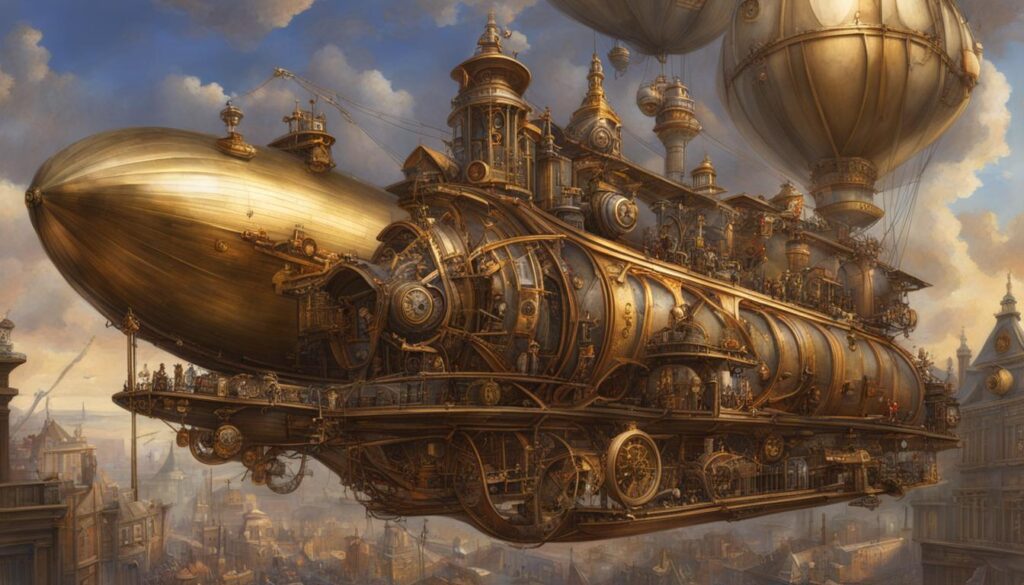
Conclusion
The world of Steampunk offers a captivating glimpse into an altered Victorian era where imagination runs wild. Combining elements of the past with futuristic ideas, Steampunk creates a rich tapestry of astonishing inventions and peculiar fashion that continues to capture the imagination of readers and creators alike. From the cobbled streets of retrofuturistic Victorian London to the sprawling landscapes of alternative history, Steampunk presents a unique vision that challenges societal norms and provides thought-provoking commentary on social issues.
Through rebellion, innovation, and social reform, Steampunk literature explores themes that resonate with readers across generations. Characters navigate a world where steam-powered technology and alternative historical narratives shape their destinies, creating exciting adventures that keep readers on the edge of their seats. By blending Victorian sensibilities with futuristic machinery, Steampunk offers a fresh perspective on history, weaving together threads of mystery, exploration, and political intrigue.
Research plays a vital role in crafting authentic Steampunk narratives. Thorough understanding of the Victorian era, from its social dynamics to its technological advancements, enables writers to seamlessly integrate real historical elements into their stories. By investing time in research, writers can create immersive worlds that transport readers to an alternative past, while maintaining the integrity of the Steampunk genre. From the intricate devices powered by steam to the social context of the time, research adds depth and credibility to Steampunk storytelling.
As the Steampunk subgenre continues to evolve, it remains an enduring testament to the power of imagination. Steampunk not only invites readers on thrilling adventures but also invites them to question the conventions of the past and reimagine the possibilities of the future. With its blend of history, fantasy, and social commentary, Steampunk offers a truly unique reading experience that leaves a lasting impression.
FAQ
What is Steampunk?
Steampunk is a subgenre of science fiction that combines elements of the Victorian era with futuristic ideas, creating a unique and imaginative vision of an altered Victorian era.
What does Steampunk draw inspiration from?
Steampunk draws inspiration from the 19th-century industrial steam-powered machinery and incorporates astonishing inventions and peculiar fashion.
How has Steampunk influenced various forms of art?
Steampunk has influenced various forms of art, including fashion and film, with its distinct aesthetic and alternative historical narratives.
What themes does Steampunk literature explore?
Steampunk literature delves into themes of rebellion, innovation, and social reform, challenging conventional norms and offering thrilling conflicts and resolutions.
Can you give examples of notable Steampunk works?
Notable Steampunk works include “The Difference Engine” by William Gibson and Bruce Sterling, “Mortal Engines” by Philip Reeve, “Boneshaker” by Cherie Priest, “Perdido Street Station” by China Miéville, and “Airborn” by Kenneth Oppel.
Why is research important in crafting an authentic Steampunk story?
Research helps writers understand the historical context of the Victorian era, including social dynamics, cultural norms, and technological advancements, adding credibility and depth to the narrative.
Source Links
- https://www.servicescape.com/blog/victorian-visions-your-guide-to-writing-steampunk
- https://www.historians.org/research-and-publications/perspectives-on-history/december-2018/steampunk-for-historians-its-about-time
- https://www.karikilgore.com/victorian-oddities-and-the-steampunk-fantasy-storybundle/

